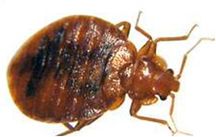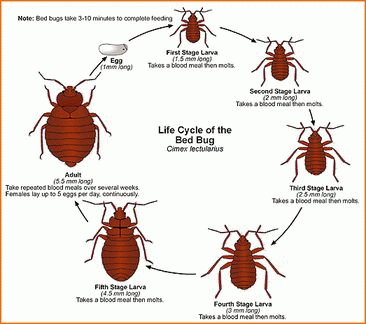 Bed Bugs (Cimex lectularius) have an oval broad, flat body and a short, broad head. Unfed adults are around 6 to 10 mm long and brown and wingless. After feeding, they swell in size and darken to a blood-red colour. The nymphs are shaped like the adults, yellow-white in colour.
Bed Bugs (Cimex lectularius) have an oval broad, flat body and a short, broad head. Unfed adults are around 6 to 10 mm long and brown and wingless. After feeding, they swell in size and darken to a blood-red colour. The nymphs are shaped like the adults, yellow-white in colour.
Itchy welts on skin and/or black or brown spots on mattresses sheets, bed frames or walls often indicate that there is a bed bug infestation.
The bed bug eggs are white, about 1 mm long (1/25 inch), and are almost impossible to see on most surfaces. The female bed bug lays at least 200 eggs in her lifetime, at a rate of about two or four per day. The eggs have a sticky coating and are deposited in cracks and crevices, behind woodwork and similar hidden locations. They usually hatch in 10 to 14 days.
Newly hatched nymphs feed as soon as food is available. A bed bug goes through five moults before it reaches full maturity. Adults usually live for around 10 months, but can live for a year or more in a home where the environment is good for reproduction, with temperatures ranging between 21°C and 28°C, making it ideal for breeding year round.
Bed bugs can live from several weeks up to roughly a year and a half without feeding. Older bed bugs can go even longer without feeding.
Bed bugs can cause allergic reactions and itchy welts. Allergic sensitivity can increase if exposure is prolonged. They do not however pose a major health risk and are not known carriers of blood-borne diseases. Bed bug bites may not be noticed immediately because bed bugs typically feed at night when people are asleep.
 Bed bugs are wingless and cannot fly or jump, but are able to hide in extremely small locations because of their flattened bodies – under wallpaper, behind picture frames, in electrical outlets, inside boxsprings, in mattress pads and in night tables. Long considered eradicated in most metropolitan areas, bed bugs are making a comeback. People now travel more than ever before, and bed bugs are hitching rides on clothing and luggage. They can now be found everywhere there is a high turnover of people, from homeless shelters to five-star hotels. They can also be accidentally transported around the house on objects. Bed bugs do not indicate a lack of cleanliness.
Bed bugs are wingless and cannot fly or jump, but are able to hide in extremely small locations because of their flattened bodies – under wallpaper, behind picture frames, in electrical outlets, inside boxsprings, in mattress pads and in night tables. Long considered eradicated in most metropolitan areas, bed bugs are making a comeback. People now travel more than ever before, and bed bugs are hitching rides on clothing and luggage. They can now be found everywhere there is a high turnover of people, from homeless shelters to five-star hotels. They can also be accidentally transported around the house on objects. Bed bugs do not indicate a lack of cleanliness.
Because bed bugs are hard to get rid of, more than one chemical treatment is required.
Be thorough in addressing bed bug infestations, because bed bugs travel easily, you may have to treat nearby rooms. Remove or reduce any clutter that might transport bed bugs. You may have to discard your bed. Holes or worn spots in the fabric may allow bed bugs to lay eggs in areas not easily reached, and there are restrictions on how insecticides can be used on beds.
Carefully examine all night tables, baseboards, dressers, headboards (especially padded ones), electrical outlets, any items stored near or under the bed, any nearby carpeting or rugs, picture frames, switch plates, inside clocks, phones, televisions and smoke detectors – in short, anything and everything that is in the room where the infestation has been noted. Upholstered chairs and sofas can also harbour bed bugs.
To prevent future bed bug infestations, mattresses must be completely enclosed. They can be wrapped in zippered bed encasements. Mattresses can also be wrapped and sealed in plastic film. Be cautious about taking in second-hand furniture, bedding, mattresses or beds. Inspect and clean them before bringing them home. When you travel, inspect the mattress and headboard in the hotel room, do not bring your pillow from home, and do not put your suitcase on the bed.
Proper preparation of a room for bed bug treatment will reduce the spread of bed bugs and help ensure a successful treatment.
Proper preparation is a mandatory requirement for control to be effective. This is generally done by the resident. If a home is not properly prepared, the likelihood of successful control is not high. Although preparation may be difficult for some people (seniors or handicapped individuals), it is essential for effective treatment, and thus in such cases family members, friends or social or charitable agencies may need to provide assistance.
Click here to view our Preparation Checklist for successful bed bug control.